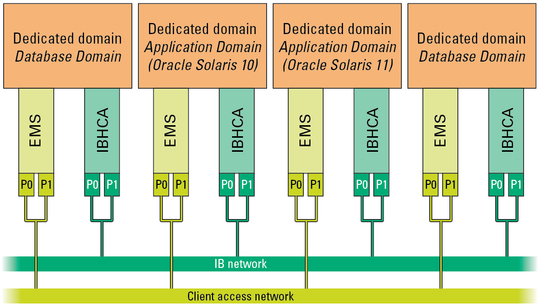| Skip Navigation Links | |
| Exit Print View | |

|
Oracle SuperCluster M6-32 Owner's Guide: Overview |
Determining SuperCluster M6-32 Configurations
Determine the Number of Compute Servers
Determine the Number of DCUs in Each Compute Server
Determine the Number of CMUs in Each DCU
Determine the Amount of Memory in Each DCU
Determine the PDomain Configuration on Each Compute Server
Determine the LDom Configuration for Each PDomain
Determining the Best Configuration for Your Situation
Understanding PDomain Configurations
Type of Configuration PDomains
Allocating CPU Resources for LDoms
CPU Resources for LDoms Flowchart
Compute Server Level Considerations
Allocating Memory Resources for LDoms
Memory Resources for LDoms Flowchart
Compute Server Level Considerations
Understanding PCIe Cards and Slots for LDoms
PCIe Cards and Slots for LDoms Flowchart
Compute Server Level Considerations
Understanding Storage for LDoms
Compute Server Level Considerations
Understanding SuperCluster M6-32
Identifying SuperCluster M6-32 Components
Understanding the Compute Server
Understanding DCU Configurations
PCIe Device Root Complexes Overview
PCIe Communication and Paths Overview
Understanding DCU PCIe and EMS Slot Locations
Understanding Half-Populated DCU Root Complexes
Half-Populated DCU 0 PCIe Slot Root Complexes
Half-Populated DCU 1 PCIe Slot Root Complexes
Half-Populated DCU 2 PCIe Slot Root Complexes
Half-Populated DCU 3 PCIe Slot Root Complexes
Understanding Fully-Populated DCU Root Complexes
Fully-Populated DCU 0 PCIe Slot Root Complexes
Fully-Populated DCU 1 PCIe Slot Root Complexes
Fully-Populated DCU 2 PCIe Slot Root Complexes
Fully-Populated DCU 3 PCIe Slot Root Complexes
Extended Configuration PDomain Overview
Understanding Extended Configuration PDomains
Understanding Four DCUs in One Compute Server (R1 Extended Configuration PDomains)
Understanding Four DCUs Across Two Compute Servers (R2 Extended Configuration PDomains)
Understanding Base Configuration PDomains
Understanding Four DCUs on One Compute Server (R3 Base Configuration PDomains)
Understanding Four DCUs Across Two Compute Servers (R4 Base Configuration PDomains)
Understanding Two DCUs on One Compute Server (R5 Base Configuration PDomains)
Understanding Two DCUs Across Two Compute Servers (R6 Base Configuration PDomains)
Understanding Compute Server Hardware and Networks
CPU and Memory Resources Overview
LDoms and the PCIe Slots Overview
10GbE Client Access Network Overview
Understanding SR-IOV Domain Types
Understanding LDom Configurations for Extended Configuration PDomains
Understanding LDom Configurations for Fully-Populated DCUs (Extended Configuration PDomains)
Understanding LDom Configurations for Half-Populated DCUs (Extended Configuration PDomains)
Understanding LDom Configurations for Base Configuration PDomains
Understanding LDom Configurations for Fully-Populated DCUs (Base Configuration PDomains)
Understanding LDom Configurations for Half-Populated DCUs (Base Configuration PDomains)
Understanding Clustering Software
Cluster Software for the Database Domain
Cluster Software for the Oracle Solaris Application Domains
Understanding System Administration Resources
Understanding Platform-Specific Oracle ILOM Features
SPARC: Server-Specific and New Oracle ILOM Features and Requirements
Unsupported Oracle ILOM Features
Oracle ILOM Remote Console Plus Overview
Oracle Hardware Management Pack Overview
Time Synchronization and NTP Service
The following SuperCluster-specific domain types have always been available:
Application Domain running Oracle Solaris 10
Application Domain running Oracle Solaris 11
Database Domain
These SuperCluster-specific domain types have been available in software version 1.x and are now known as dedicated domains.
Note - The Database Domains can also be in two states: with zones or without zones.
When SuperCluster M6-32 is set up as part of the initial installation, each domain is assigned one of these three SuperCluster-specific dedicated domain types. With these dedicated domains, every domain in SuperCluster M6-32 has direct access to the EMSs and IB HCAs (and Fibre Channel cards, if those are installed in the card slots). The following graphic shows this concept on SuperCluster M6-32 with four domains.

With dedicated domains, connections to the 10GbE client access network go through the physical ports on each EMS, and connections to the IB network go through the physical ports on each IB HCA, as shown in the following graphic.

With dedicated domains, the domain configuration for SuperCluster M6-32 (the number of domains and the SuperCluster-specific types assigned to each) are set at the time of the initial installation, and can only be changed by an Oracle representative.